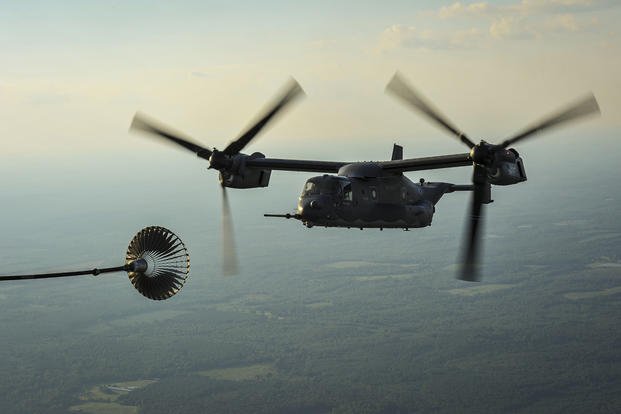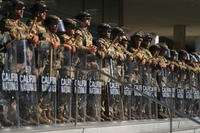The Air Force said Tuesday that investigators have determined a parts failure occurred during an Osprey crash in Japan in November that killed all eight airmen on board, but the root cause of the crash is still unknown.
Air Force Special Operations Command said in a statement that the two investigations into the deadly crash, a Safety Investigation Board probe and an Accident Investigation Board inquiry, are still ongoing.
"At this time, the material failure that occurred is known, but the cause of the failure has not been determined," Air Force Special Operations Command said. "Engineering testing and analysis is ongoing to understand the cause of the material failure, a critical part of the investigation."
Read Next: VA Paid Roughly $1 Million in Double Housing Payments to Some Student Vets Due to a Legal Loophole
Prior to Tuesday's determination, the Osprey fleet had already been under intense scrutiny following other deadly mishaps and a mysterious mechanical issue -- called a hard clutch engagement, an issue that occurs in the V-22 gearbox -- that has been seen in the aircraft for more than a decade.
Despite little news coming from official channels, officials inside the Pentagon, speaking anonymously, have told news outlets over the past two weeks that the investigation was progressing and eyeing the aircraft's complex series of clutches and gearboxes as a potential culprit.
The Associated Press has reported that the Pentagon believes it has identified the mechanical failure that caused the crash in Japan, while NBC News reported that investigators were looking at the aircraft's propeller rotor gear box as a possible cause for the crash. The Air Force statement did not specify the aircraft's propeller rotor gear box as the issue.
Military.com offered several military officials the opportunity to deny the reports and none did so on the record.
The V-22 Joint Program Office, which oversees all the service's Ospreys, offered Military.com no new details Tuesday and instead said that "preliminary information provided by the Safety Investigation Board indicates a potential materiel failure, but the root cause is unknown at this time." That statement is similar to what was offered by the Air Force in December.
Tuesday's statement from Air Force Special Operations Command shores up an initial assessment it gave shortly after the Nov. 29 crash that indicated a mechanical failure may have been to blame.
The Air Force special operations Osprey that went down, call sign Gundam 22, was on a training mission off Japan's Yakushima Island. The deadly crash triggered a grounding of all Air Force, Marine Corps and Navy V-22s. Those service stand-downs and multiple investigations into the mishap are still ongoing.
All of the services that fly the V-22 rely on them for operations and transport, and many officials have stated publicly that they wish to get them back in the air again.
Lt. Gen. Tony Bauernfeind, head of Air Force Special Operations Command, said during a roundtable with reporters last week at the Air and Space Forces Association's Warfare Symposium conference in Colorado that he wants the Air Force to utilize the CV-22, that service's variant of the Osprey, as soon as possible.
"There is a strong desire to return to fly because that is a capability we want to have, but we want to be able to return to fly with as much knowledge as we possibly can so that we can ensure that we are safely taking care of our crews as it goes forward," Bauernfeind told reporters.
The Marine Corps, which utilizes the majority of the military's V-22s with its MV-22 variant, told Military.com on Tuesday it is eager to get them back in the air, but did not have any insight into when that would be.
"Safely returning the MV-22 to flying status is one of our top priorities," said Capt. Alyssa Myers, a Marine Corps spokeswoman. "We cannot speculate on timelines."
Last week, a top Marine Corps general told a conference panel that the Corps has seen "dramatic impacts" from the flying halt.
Pentagon spokeswoman Sabrina Singh told Military.com on Tuesday that it's up to the individual services "to determine when it's best for those Ospreys to be relieved of that stand-down order."
In addition to the incident in Japan, three Marines were killed in August when their MV-22 Osprey crashed during training in Australia -- the cause has yet to be publicly confirmed by the service -- and five Marines died in 2022 when their Osprey suffered a catastrophic clutch failure during training in California.
When the cause of the 2022 Osprey crash was revealed to be a hard clutch engagement last year, the office that runs the Osprey program for the Pentagon claimed "through a combination of efforts, including the recent input quill assembly replacement bulletin in February 2023, the risk of a [hard clutch engagement] event occurring was reduced by greater than 99%" despite no clear understanding of what causes the problem. The claim was met with skepticism from relatives of the victims.
In addition to those revelations and incidents, just two months prior to the Nov. 29 Osprey crash, two Marine V-22 Ospreys in Japan diverted Sept. 14 within hours of each other due to "cockpit caution indications" in the aircraft while flying near where the Air Force Osprey later crashed, Military.com previously reported.
The last deadly Air Force Osprey crash occurred in 2010, when three service members and a civilian contractor died in Afghanistan, according to Air Force Safety Center data. The cause could not be determined by an investigative board.
Since 1992, the aircraft, which can fly like both a helicopter and a plane, has been involved in numerous crashes, accidents and mishaps, leading to more than 60 deaths. After the clutch issues became public in August 2022, the Marine Corps revealed it knew about the issue as far back as 2010 and that there have been at least 15 mishaps linked to the "hard clutch issue," with 10 involving Marine Corps aircraft.
Search efforts in the Nov. 29 crash involved more than 1,000 personnel, 46 aircraft, 23 maritime vessels, and 21 unmanned air and watercraft looking for wreckage and remains, covering more than 60,000 square kilometers of the ocean surface and 39 square kilometers of the ocean floor, according to the Air Force.
The U.S. military last month concluded its search efforts after 43 days of recovery and salvage efforts. Remains of seven airmen who died in the Nov. 29 mishap were located, recovered and identified during the search off the southern tip of mainland Japan, but Air Force Special Operations Command said in a statement that the body of Maj. Eric Spendlove could not be found.
Last month, Military.com reported that the Government Accountability Office agreed to look into the Osprey incidents following a request by Reps. John Garamendi, D-Calif., and Mike Waltz, R-Fla. The lawmakers asked the agency "to conduct a review on the cause of the accidents that have resulted in several deaths involving the Osprey tilt-rotor aircraft (V-22) during military operations and training exercises."
Since the Nov. 29 crash, however, the Pentagon has not announced its own investigation into all the incidents involving the Osprey in recent history. Military.com reported last year that the Air Force, Marines and Navy have stopped new purchases of the aircraft and said only that they "will complete the MV-22 and CMV-22 programs of record, with deliveries through 2025."
Related: Air Force Has 'Strong Desire' to Fly Osprey Again Following Deadly Crash, But Questions Remain

















